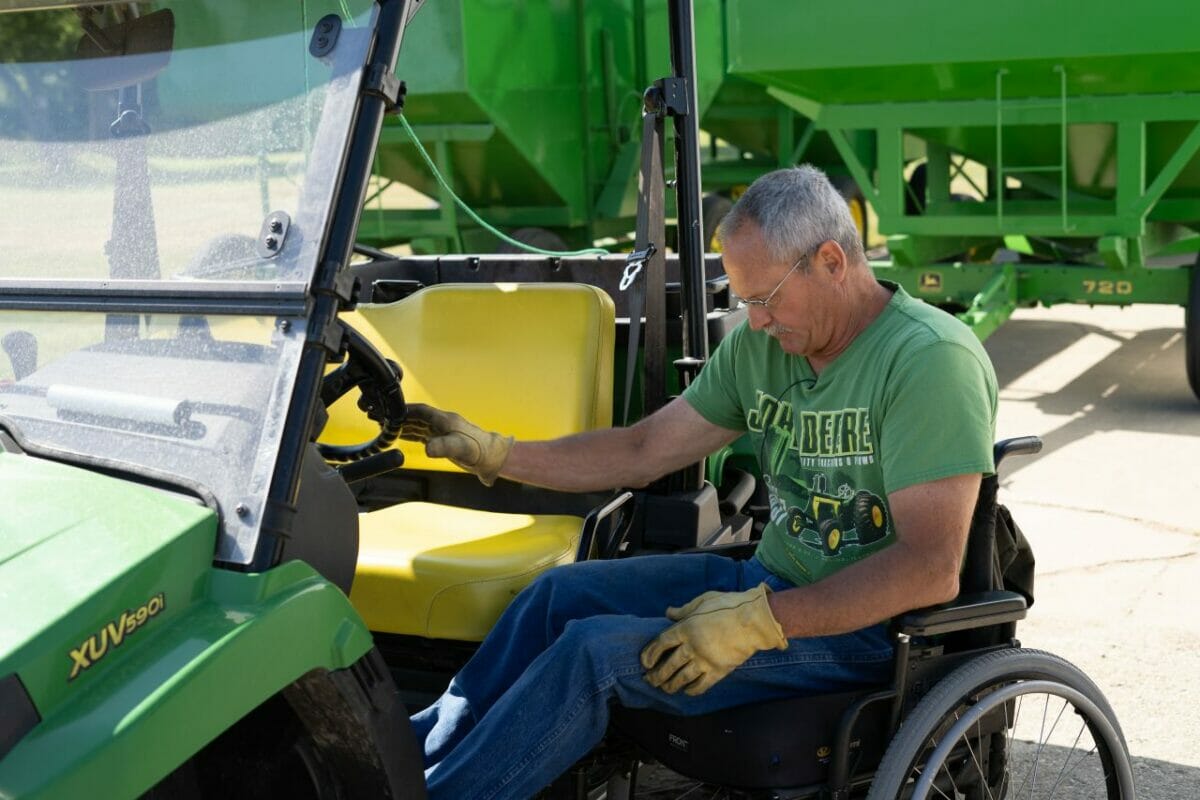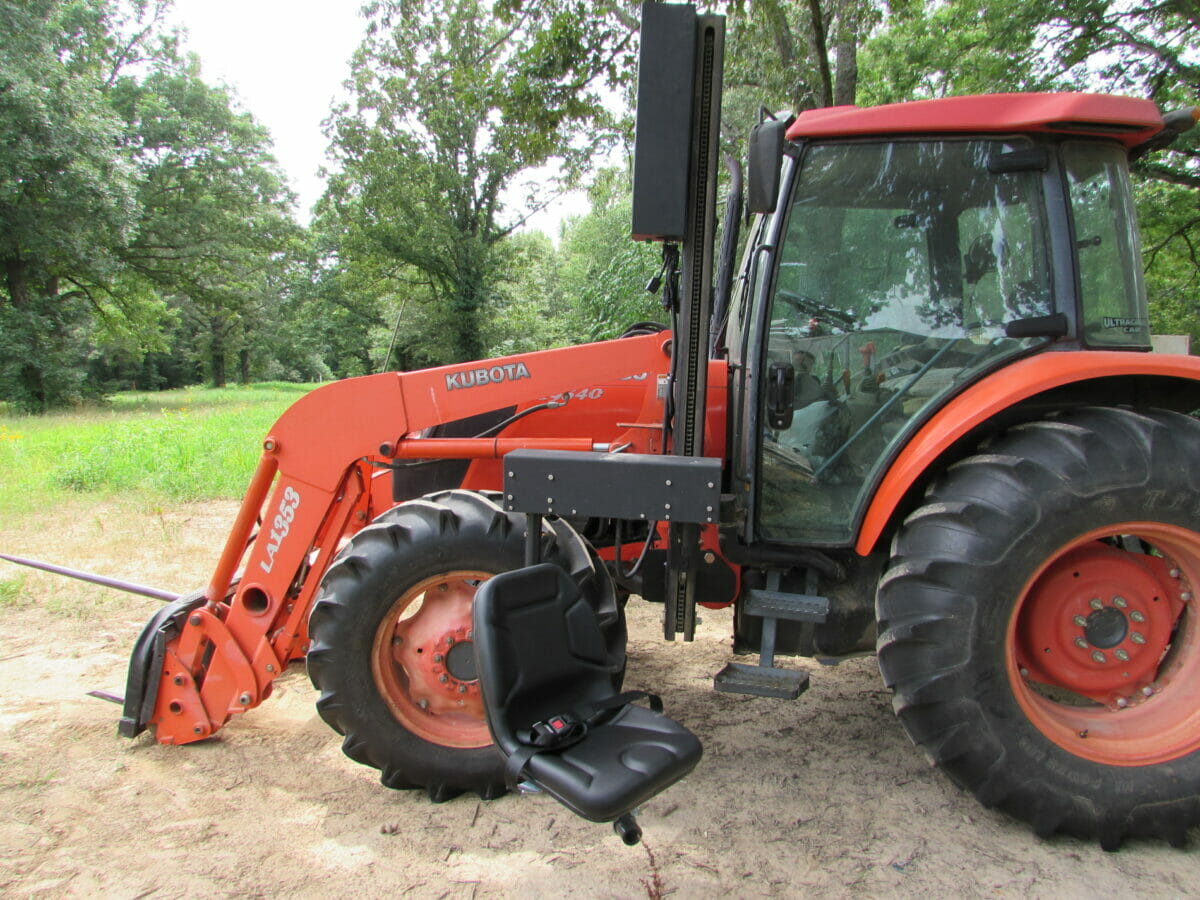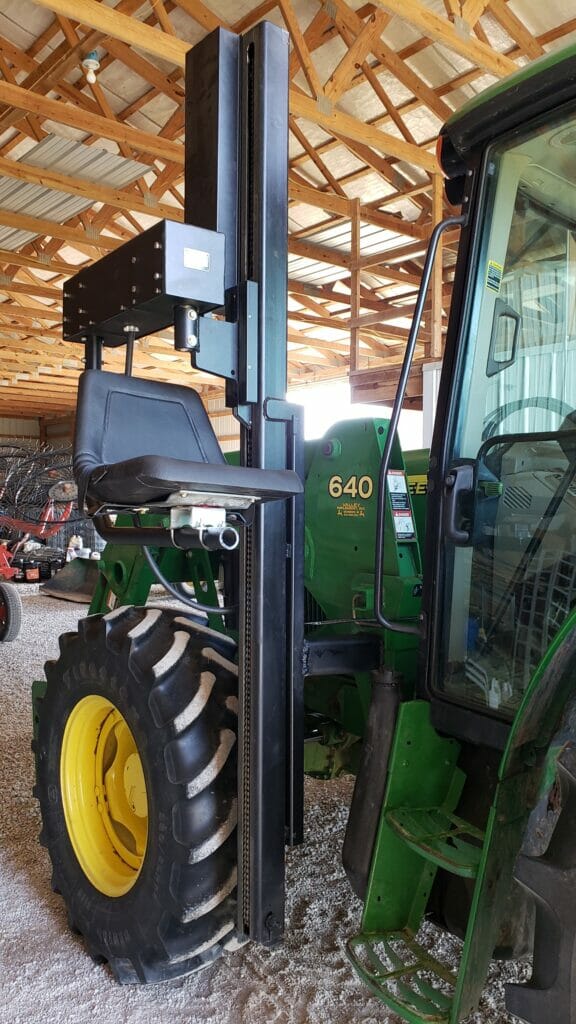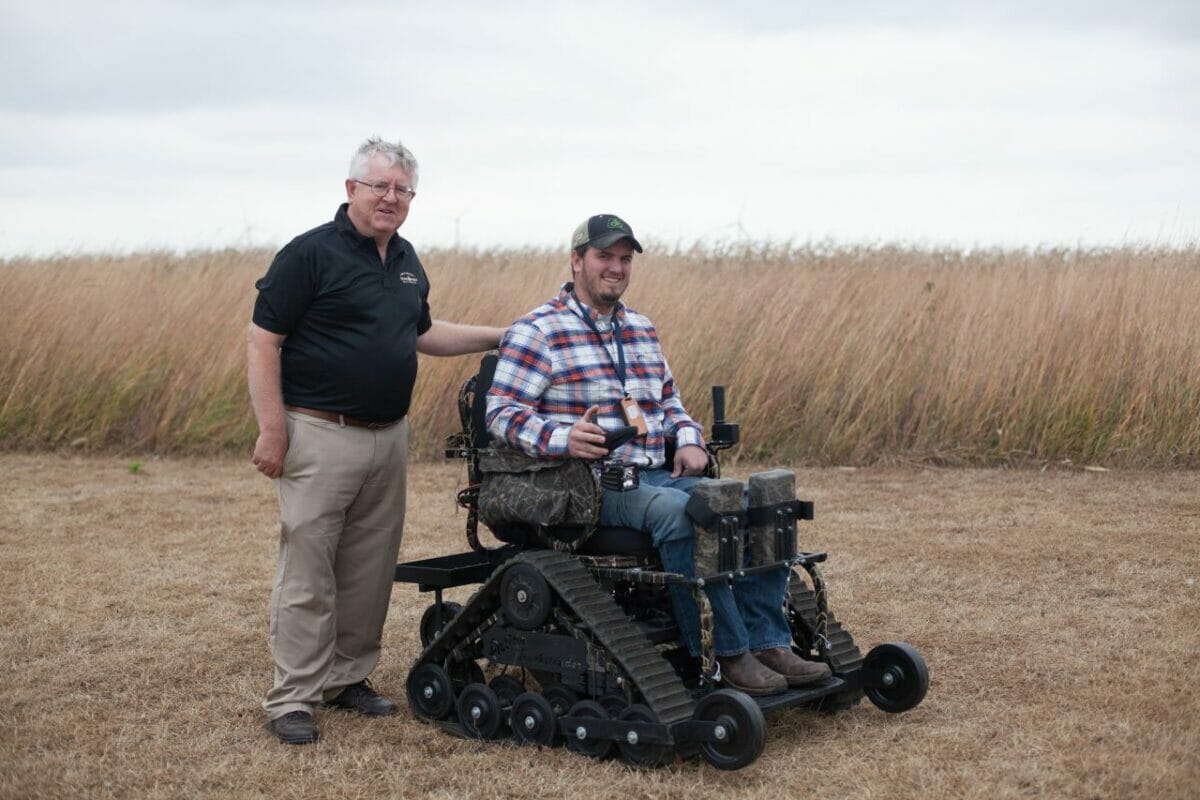Meeting the Growing Need for Accessible Agriculture
These companies and programs specialize in modifying farming equipment to make it usable and comfortable for all bodies.
Meeting the Growing Need for Accessible Agriculture
These companies and programs specialize in modifying farming equipment to make it usable and comfortable for all bodies.

Several programs work to develop assistive technology for use by farmers with disabilities.courtesy of AgrAbility.
On most combine harvesters, the ladder runs straight up and down, with no curvature over the wheel. On some, the first step to that ladder is 33 inches up, more than two-and-a-half feet off the ground. That’s a hefty hike up and a big drop down, especially when you’re climbing in and out of the machine multiple times a day.
For some farmers, that’s not a comfortable maneuver. Although the cultural image of a farmer that persists in the media is often a rugged, fit and able-bodied man in his 40s, the reality is often quite different. The average age of a farmer in America is close to 60, according to the most recent Census of Agriculture. More female farmers are getting into the business. In addition, a career in agriculture comes with inherent risk. The job is highly physical, involving working alongside heavy machinery and specialized tools. Accidents and injuries on farms happen all too often, with about 100 agricultural workers injured per day. And farmers with mobility issues, disabilities or injuries may still want—and often need—to work. A one-size fits all approach to farming equipment just doesn’t work.
To help make agriculture more accessible for users, dozens of companies around the country specialize in making adaptations for tractors, lawn mowers, ATVs, gates and most other farm equipment.
One of those companies is Life Essentials, which adapts equipment to fit farmers’ individual needs. The business dates to the 1980s, when it was founded by Hubert Von Holten, who had polio as a child and wore braces on his legs. That didn’t stop him from pursuing a career in farming, even as he had difficulty getting in and out of his combine. Instead, he built himself a lift to help him do so. That lift gained some attention, so he built some more.

In 2002, Von Holten’s wife, Kathleen Smith, purchased Life Essentials and took over his duties, giving her husband the chance to retire. Since then, she’s grown the business’s offerings to include all sorts of customized mobility equipment. “We make lifts that mount [to the equipment], people can swing around, get on a lawnmower, and we put hand controls on tractors to be able to operate the pedals,” says Smith. “But the biggest request is a lift that mounts on the back of a flatbed pickup truck.”
Smith explains that the lift attaches to the bed of the truck, swinging around to help hoist individuals in and out of the vehicle, as well as into and out of any other equipment. The arm of the hydraulic lift raises up 12 feet high and 14 feet out to the side. “We have a guy that works on a road crew. He drives it to work and he gets into his bulldozer or whatever he has to use that day, and he can get into anything with that,” says Smith.
Many companies like Life Essentials are connected with groups such as AgrAbility, a national program that works to support farmers and agricultural workers with disabilities. Although it is headquartered in Indiana, AgrAbility has chapters in 21 states. Each chapter operates independently, funded by grants from the USDA, helping people find gainful employment, sharing information about treatment of rehabilitation programs and connecting folks with assistive technologies.

With so many options available, AgrAbility has developed an online database it calls the Assistive Technology Toolbox, which gives users access to hundreds of mobility aids and helpful gadgets. “Take the outdoor mobility section,” says Paul Jones, manager of the national AgrAbility project. “Within that, we’ve got outdoor walking and navigation, and then we’ve got eligible wheelchairs and accessories. And within that, it’s divided between wheeled wheelchairs and trek wheelchairs.”
This versatility of adaptable options helps users hone in on their specific needs. “If you’re going to be in a greenhouse, [the wheelchair you want] will depend on how wide your rows are, that type of thing,” says Jones.
AgrAbility also focuses on a specific group of farmers with a unique set of needs: veterans. Existing programs, such as the Farmer Veteran Coalition, help vets transition to agricultural work after their military service. They’ve found that, for many veterans, the new career path is a good fit. However, veterans may also need specific help and resources, as they have “more incidents of PTSD or other kinds of mental and behavioral health issues,” says Jones. “In that population, there might be more incidents of traumatic brain injury from some type of explosion.” Additionally, many vets are new to farming and need general guidance in the business.

While AgrAbility doesn’t have a chapter in every state, Jones says it does provide some assistance to similar organizations and groups around the country. He’d like to grow the project’s reach. Of course, that would require funding, which isn’t always easy to come by, even when it’s laid out in the Farm Bill.
And while Jones notes that there are always worthwhile programs that need funding, it can be difficult to showcase why efforts like theirs are so necessary. “Unless you’ve got a disability, you don’t really think about things like assistive technology or what kinds of social services might be available,” he says. “The people we work with never had a clue until they got injured.” With more funding, Jones says, he hopes that AgrAbility could expand its reach and support more beginning farmer efforts across the country, including programs focused on BIPOC farmers.
Even if some of these equipment modifications and custom builds seem like fringe accessories to some people now, they’re bound to become more common in the coming years. Many new farmers joining the industry need accommodations. And as farmers age, they’re going to need to change how they work and how they access their equipment.
“People get arthritis working on the farm…They jump off trailers, they jump off the back of their trucks and hurt their knees,” Smith says. “As they’re getting older, these things just don’t work as well as they did when they were young.” Despite the toll farming can take on one’s body, Smith says most of the farmers she meets wouldn’t dream of changing careers or retiring early. There’s a reason that these companies work with farmers to adapt equipment and offer support, rather than retraining them for other careers.
“That’s what they love,” says Smith, who recalls a farmer with whom she worked in Illinois. The farmer had recently bought a new combine and had trouble climbing up into it. Life Essentials added a lift to the side, so he would be able to raise himself up to the cab. “He was 95 years old, and it was his birthday. That was his birthday present to himself, to get into this brand new combine. I think he did maybe two more seasons before he passed, but that was where he wanted to be. That’s what he loved.”
Rather than get discouraged, Smith encourages aging farmers to look into succession planning and think about how their routines will change as they age or if they get injured. “We’re here to help them continue farming,” she says. “They don’t have to suffer.”
Follow us
This work is licensed under a Creative Commons Attribution-NoDerivatives 4.0 International License.
Want to republish a Modern Farmer story?
We are happy for Modern Farmer stories to be shared, and encourage you to republish our articles for your audience. When doing so, we ask that you follow these guidelines:
Please credit us and our writers
For the author byline, please use “Author Name, Modern Farmer.” At the top of our stories, if on the web, please include this text and link: “This story was originally published by Modern Farmer.”
Please make sure to include a link back to either our home page or the article URL.
At the bottom of the story, please include the following text:
“Modern Farmer is a nonprofit initiative dedicated to raising awareness and catalyzing action at the intersection of food, agriculture, and society. Read more at <link>Modern Farmer</link>.”
Use our widget
We’d like to be able to track our stories, so we ask that if you republish our content, you do so using our widget (located on the left hand side of the article). The HTML code has a built-in tracker that tells us the data and domain where the story was published, as well as view counts.
Check the image requirements
It’s your responsibility to confirm you're licensed to republish images in our articles. Some images, such as those from commercial providers, don't allow their images to be republished without permission or payment. Copyright terms are generally listed in the image caption and attribution. You are welcome to omit our images or substitute with your own. Charts and interactive graphics follow the same rules.
Don’t change too much. Or, ask us first.
Articles must be republished in their entirety. It’s okay to change references to time (“today” to “yesterday”) or location (“Iowa City, IA” to “here”). But please keep everything else the same.
If you feel strongly that a more material edit needs to be made, get in touch with us at [email protected]. We’re happy to discuss it with the original author, but we must have prior approval for changes before publication.
Special cases
Extracts. You may run the first few lines or paragraphs of the article and then say: “Read the full article at Modern Farmer” with a link back to the original article.
Quotes. You may quote authors provided you include a link back to the article URL.
Translations. These require writer approval. To inquire about translation of a Modern Farmer article, contact us at [email protected]
Signed consent / copyright release forms. These are not required, provided you are following these guidelines.
Print. Articles can be republished in print under these same rules, with the exception that you do not need to include the links.
Tag us
When sharing the story on social media, please tag us using the following: - Twitter (@ModFarm) - Facebook (@ModernFarmerMedia) - Instagram (@modfarm)
Use our content respectfully
Modern Farmer is a nonprofit and as such we share our content for free and in good faith in order to reach new audiences. Respectfully,
No selling ads against our stories. It’s okay to put our stories on pages with ads.
Don’t republish our material wholesale, or automatically; you need to select stories to be republished individually.
You have no rights to sell, license, syndicate, or otherwise represent yourself as the authorized owner of our material to any third parties. This means that you cannot actively publish or submit our work for syndication to third party platforms or apps like Apple News or Google News. We understand that publishers cannot fully control when certain third parties automatically summarize or crawl content from publishers’ own sites.
Keep in touch
We want to hear from you if you love Modern Farmer content, have a collaboration idea, or anything else to share. As a nonprofit outlet, we work in service of our community and are always open to comments, feedback, and ideas. Contact us at [email protected].by Emily Baron Cadloff, Modern Farmer
November 15, 2021
Modern Farmer Weekly
Solutions Hub
Innovations, ideas and inspiration. Actionable solutions for a resilient food system.
ExploreExplore other topics
Share With Us
We want to hear from Modern Farmer readers who have thoughtful commentary, actionable solutions, or helpful ideas to share.
SubmitNecessary cookies are absolutely essential for the website to function properly. This category only includes cookies that ensures basic functionalities and security features of the website. These cookies do not store any personal information.
Any cookies that may not be particularly necessary for the website to function and are used specifically to collect user personal data via analytics, ads, other embedded contents are termed as non-necessary cookies.
Great idea. Need to get the manufacturers involved, too. If they think about it, providing the aids is more money for them.
Want to know more about modern farming equipments with very little or less cost
As Otis said below, need to get the equipment manufacturers involved. And not just for farm equipment and differently abled people. I can tell you as a 5’2” tall person that EVERYTHING in this country is designed and built for 6’ tall people. I have issues just using our riding mower to do the lawn— if I sit far enough forward on the seat to reach the pedals, I don’t have enough weight on the back of the seat to deactivate the kill switch. Handles and hand controls are spaced to widely apart for people with small hands to operate… Read more »